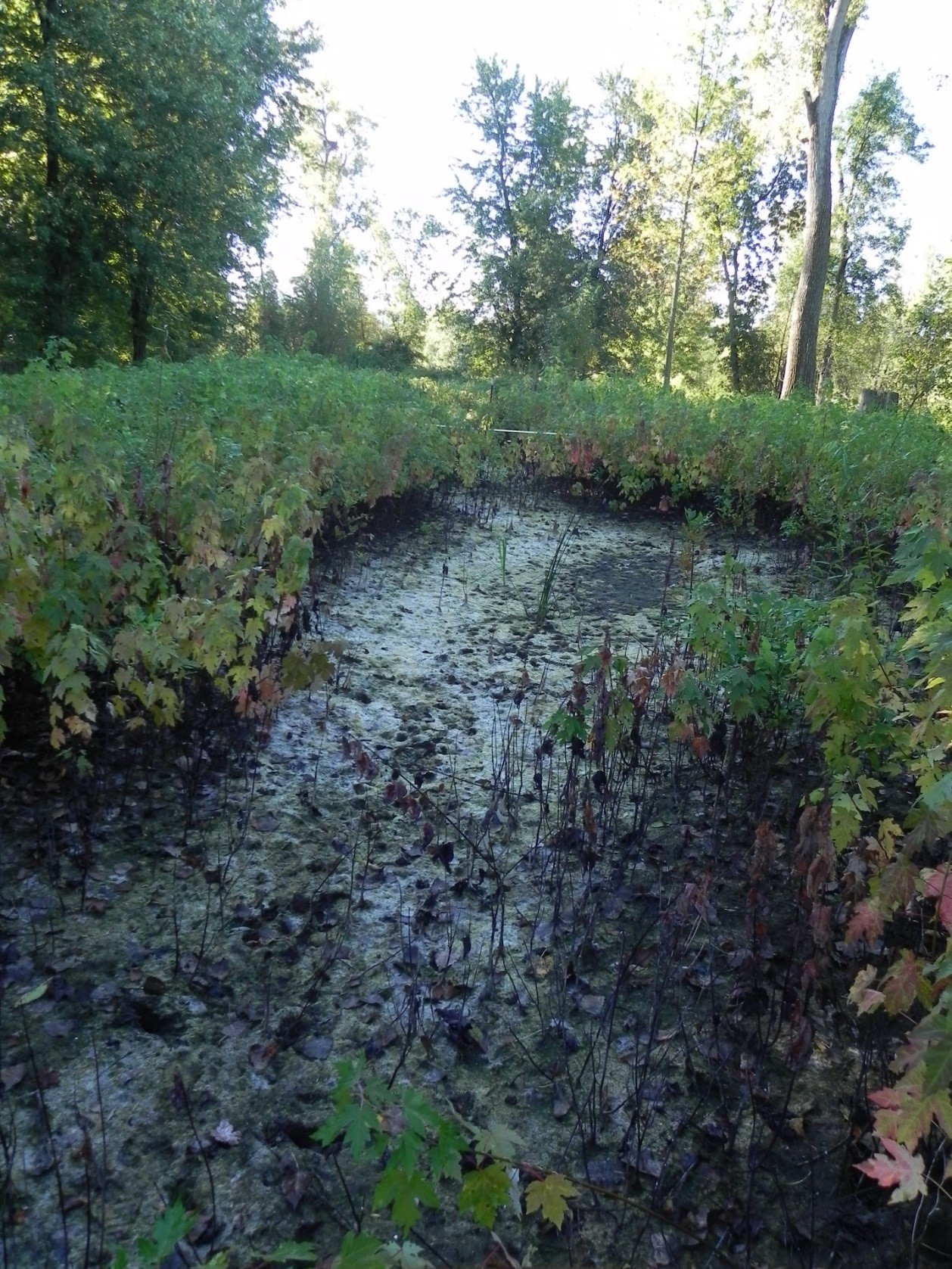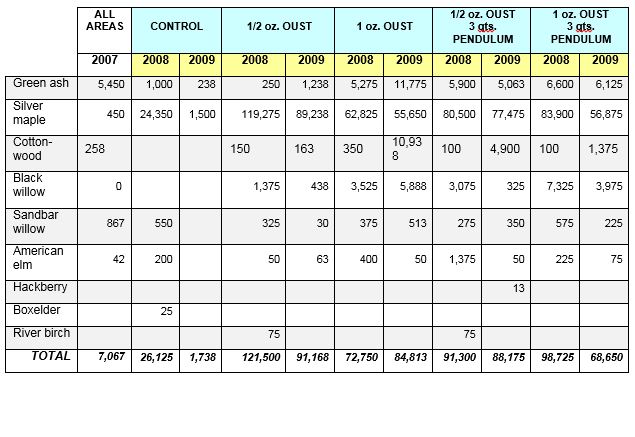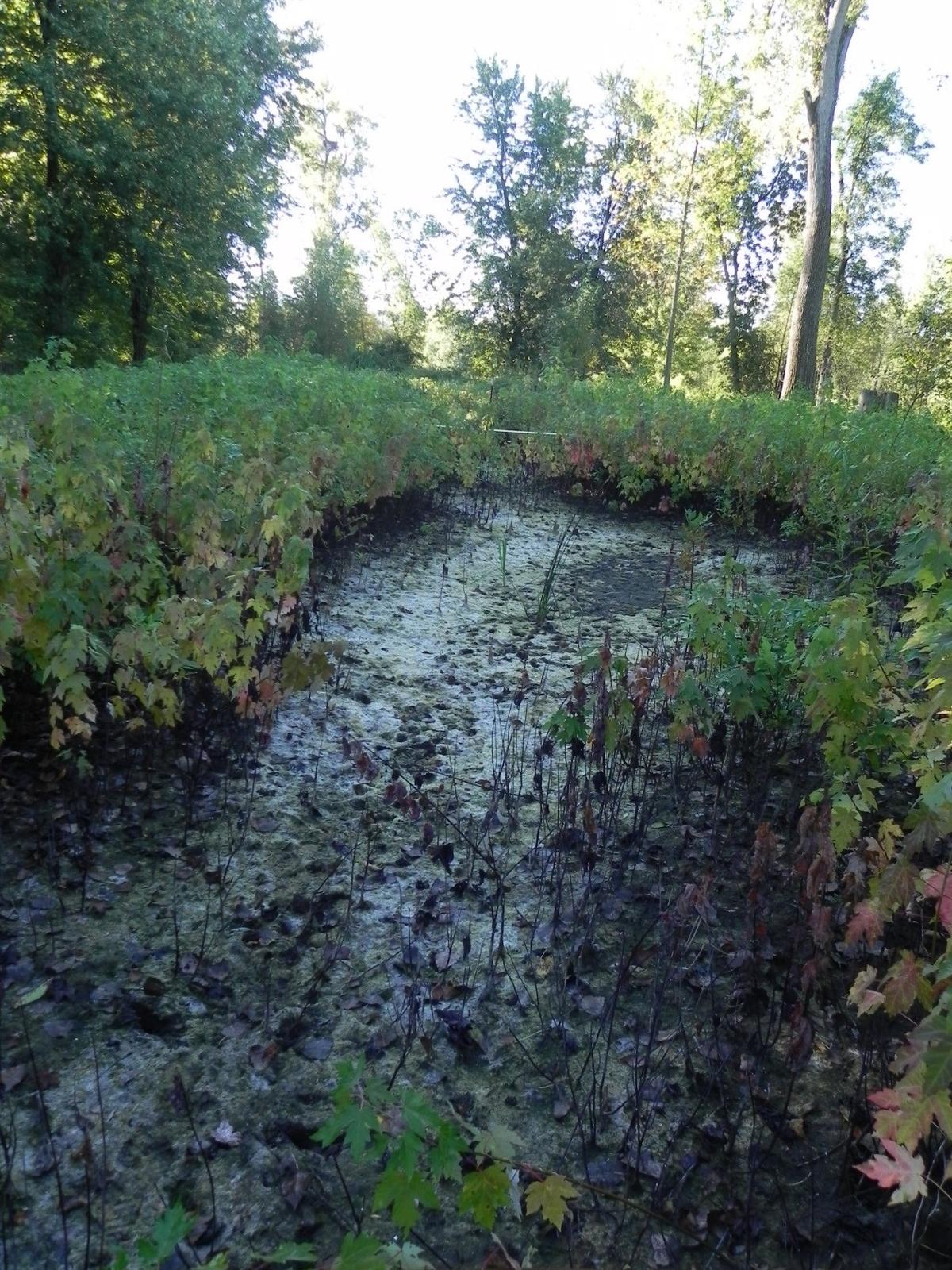Overview
Following a blow down caused by straight-line winds in 1998, timber sales were initiated within multiple stands in this compartment, including Unit 001 and Unit 003. The sites were salvage logged and during the spring 2000 slash was piled and the sites scarified with a D-6 Cat. The site preparatory work was timed to provide exposed mineral soil conditions just prior to seed fall and promote natural regeneration of various floodplain forest species. Follow-up monitoring showed significant germination of cottonwood (Populus deltoides), silver maple (Acer saccharinum), and green ash (Fraxinus pennsylvanica).
Bottomland hardwood stand data:
River: Mississippi River
River type: Major river
Floodplain topographic position: Bottom, floodplain (not terrace)
Silviculture Objective(s)

Figure 1: A representative image from the site
This site was used as an opportunity to test different mechanical and chemical site preparation treatments to encourage the establishment of natural bottomland forest tree regeneration and to discourage the colonization of the site by reed canary grass.
Pre-treatment stand description and condition
Stand establishment and management history:
From the 1938 aerial, it appears that most of this area was very young, regenerating forest or shrub cover. There is also evidence that the stream that currently runs to the south of the stand actually meandered through the stand in the 1930s, indicating that there has been some re-direction of drainage in the area. Prior to the 1998 blow down and salvage harvest, there is no evidence of other management in this stand between establishment in the mid-1930s and 1998.
Pre-treatment species composition:
Overstory composition: Anecdotal descriptions characterize the site prior to the blowdown as being dominated by cottonwood, silver maple and river birch.
Table 1: Best available information about overstory composition.
|
Species |
Mean Diameter |
BA |
TPA |
% BA |
|
Silver maple |
12 |
NA |
NA |
NA |
|
Cottonwood |
17 |
NA |
NA |
NA |
|
Black willow |
12 |
NA |
NA |
NA |
Pre-treatment growth and stocking:
Natural regeneration three years following blowdown but prior to herbicide treatments (U001)
Table 2: seedling composition in 2022.
| Seedlings per acre: |
2002 |
|
Green ash |
225 |
|
Silver maple |
488 |
|
Cottonwood |
288 |
|
Black willow |
388 |
|
Sandbar willow |
0 |
|
American elm |
50 |
|
TOTAL |
1439 |
Table 3: Best available information about overstory conditions in 1990.
|
Overstory |
|
|
Year of data collection |
1990 |
|
Basal area (ft2/ac) |
128 |
|
Trees per acre |
NA |
|
Mean Diameter |
NA |
Pre-treatment forest health issues:
Senescing canopy with substantial reed canary grass encroachment into the understory.
Landowner objectives/situation:
Regenerate floodplain forest trees.
Silviculture Prescription
This harvest was purely a salvage operation to remove all downed and damaged trees and, as such, there was no explicit determination of a silvicultural system to use nor of residual stand basal area or stocking. Scattered canopy trees were left following harvest but no data is available to quantify the number. The salvage was timed to occur in spring to allow for soil scarification at the time of logging. To minimize site damage and damage to underground wires associated with adjacent radio towers, equipment accessed the site over geo-textile and chain link pads. The site was treated as an adaptive management opportunity, so the prescription called for some experimentation with herbicides to be used to prevent establishment of reed canary grass and promote establishment of trees. Details of the applications are provided in the following sections.
What actually happened during the treatment
2000: The sites were salvage logged and during the spring 2000. Volumes harvested in the area is shown in the table below:
|
Species |
MBF |
|
Cottonwood |
113.6 |
|
Silver maple |
19.0 |
|
Black willow |
5.1 |
|
Green ash |
2.8 |
|
Total |
137.9 |
Slash was piled and the sites scarified with a D-6 Cat. The site preparatory work was timed to provide exposed mineral soil conditions just prior to seed fall and promote natural regeneration of various floodplain forest species. However, the sites quickly became dominated by reed canary grass (Phalaris arundinecea), which threatened the survival of the new tree seedlings.
Arsenal (imazapyr, EPA reg. no. 241-346) and Vantage (sethoxydim, EPA Reg. No. 7969-88-829) were applied on 18 May 2000 at 3 oz. and 24 oz. per acre rates respectively with 30 gallons of water in order to control herbaceous (primarily reed canary grass) competition. A follow-up treatment was applied on 19 July 2000 with Vantage only at 24 oz. per acre. Arsenal was applied in the first treatment as data at the time indicated that good control of reed canary grass could be achieved with that herbicide.
2001: Due to high water conditions in 2001, no spring applications of herbicide could be made. An application of Vantage was made at three pints per acre and 40 gallons of water in August of 2001.
2002: Treatment was not possible in 2002 due to intermittent high water throughout the growing season.
2003: High water in 2003 once again prevented treatment at the optimal early spring timeframe. An experimental application of Plateau (ammonium salt of imazapic, EPA reg. no. 241-365) only was applied in a small area of compartment 3 only on July 1, 2003 at a rate of 12 oz per acre. While complete kill was not achieved, the reed canary grass was stressed and stem densities were reduced. The use of Plateau in floodplain sites will likely be limited, however, due to the potential for leaching through coarse-grained soils (e.g. alluvial sands) common in floodplains. Soils at this site are fine grained and leaching into groundwater is not likely.
2004: On May 3, 2004, Plateau was applied to approximately 2 acres as an experiment. The trees were leafing-out already by the time that spring high water receded enough to spray and it was thought that an experiment would be in order to determine exactly what effects, if any, Plateau applied at a rate of 12 oz./acre would have on the tree seedlings. Vantage was applied at a rate of 48 oz./acre to a total of approximately 2.3 acres, since Vantage will not harm the tree species of interest at any stage. The problem at this site is that in order for Vantage to be effective, reed canary grass must be treated early in the season when new growth is short. This is usually not possible due to spring high water at the site.
2006: On July 21, 2006 the site was visited by a multi-agency group attending a forestry coordination meeting. It was the consensus of the group that natural regeneration was not sufficient in places, especially on the northern sections where herbicide treatment was not possible due to numerous slash piles. The group recommended that additional actions be taken in an effort to facilitate regeneration.
In early November 2006 a FECON® mower was used within Compartment to clear areas where regeneration was non-existent or inadequate. The total area treated was approximately 3.3 acres. The mower chopped slash and broke ground to prepare a seedbed for bottomland hardwood regeneration. Inadequate site preparation was achieved in some areas and a local farmer with a Lely Rotera® tiller was contracted with to further scarify the site. On November 9, 2006, the site was treated with one of the following four pre-emergent herbicide treatments:
- ½ ounce Oust® (sulfometuron methyl, EPA reg. no. 432-1552) and 3 quarts of Pendulum® (pendimethalin, EPA reg. no. 241-416) per acre,
- 1 ounce Oust and 3 quarts of Pendulum per acre,
- ½ ounce Oust per acre,
- 1 ounce Oust per acre.
The four scenarios were designed in order to answer questions regarding whether amounts of Oust exceeding ½ ounce per acre will inhibit bottomland hardwood germination. Pendulum was used to augment Oust activity because of concerns that that low rates of Oust may not be sufficient to control reed canary grass.
On 17 November 2006 approximately 2 1/2 to 3 bushels of green and black ash seed were hand broadcast on the site. Areas furthest from the woods were given priority.
2007: During the spring 2007, an attempt was made to supplement natural seed fall with seed collected by Corps of Engineers personnel. Unfortunately, cottonwood and silver maple seed was practically non-existent. A grocery bag of river birch (Betula nigra) was scattered over the site on 5 June 2007.
On 4 June 2007 Sethoxydim G-Pro (sethoxydim, EPA reg. no. 79676-4) was applied in select areas that appeared to have been missed in 2006. The reed canary grass in these areas greened-up early and grew vigorously, in comparison to adjacent areas where there was no sign of reed canary grass.
The reed canary grass that was treated in June seemed to respond well to the treatment and browned fairly quickly. Unfortunately by the middle of July most of the site had some reed canary grass. On 27 July 2007 sethoxydim was applied to the entire site for reed canary grass and transline was used in the far south polygon to treat thistle.
On 8 November 2007 the entire site was treated with various combinations of Oust® and Pendulum as was done in fall 2006. In addition to this, glyphosate was applied to some of the area at a range from 1-2 quarts per acre a total cost of $396.81.
2008: On 10 April 2008 several thousand cuttings of red osier dogwood (Cornus stolonifera), black willow (Salix nigra), and sandbar willow (Salix interior) were planted. The willow seemed to grow well in all treatment areas while the dogwood did not appear to do well.
On 27 May 2008, approximately 65,000 Dutch elm disease tolerant American elm (Ulmus americana) seeds were broadcast on the site. This was followed by a month long flood that may have contributed to the almost complete failure of these seeds to germinate on the site.
On 2 June 2008 approximately 1.5 bushels of silver maple seeds were broadcast on the site.
On 5 June 2008 another 1.5 bushels of silver maple seeds were broadcast on the site.
On 23 July 2008 woody regeneration surveys were conducted throughout site. Results showed an average of 97,400 stems per acre for all the treated areas and 26,100 stems per acre in the controls.
On 28 July 08 the site was spot treated for thistle with the herbicide Milestone® (aminopyralid, EPA reg. no. 62719-519).
On 20 November 08 the entire site was treated with various combinations of Oust® and Pendulum® as was done in fall 2006 and 2007. Although desired, glyphosate was not applied since the tree seedlings did not senesce until the grass was almost completely dead.
2009: For growing season control of reed canary grass at WKTY, the herbicide Intensity® (clethodim, EPA Reg. No. 34704-864
On April 30, 2009, Corps of Engineers staff and volunteers planted willow cuttings on the NW half of the site.
On May 27, 2009, Corps of Engineers summer staff direct seeded disease-tolerant American elm seed on the SE half of the site.
In June 2009 there were two applications of the herbicide Intensity (clethodim, EPA Reg. No. 34704-864). The actual rates are not directly documented for the site, though the initial prescription called for application across on the entire site at a rate of 1.5 oz per gallon. Herbicide application summaries for 2009 do indicate that 0.12 gallons of Intensity were sprayed on Corps of Engineer land in the St. Paul District, so it is most likely that it was applied.
2010-2012: There were no recorded treatments on the site for this period.
Post-treatment assessment

Figure 2: Post-treatment regeneration survey data
Regeneration surveys in 2008 and 2009 in U001 showed substantially higher seedling densities in areas treated with herbicide subsequent to mechanical site prep than in areas without herbicide application, as shown in the table in figure 2 above. Unfortunately, no height data is available so regen numbers include all seedlings.
Forest inventory has not been completed in the area since 1990, so there is no current quantitative data related to overstory canopy conditions. However, anecdotal observations indicate that there are very few residual canopy trees in the blowdown areas while the areas adjacent to the blowdown retain good canopy density of large diameter cottonwood and silver maple.
The site was visited by Corps of Engineers staff in 2013 to assess conditions in the salvage timber harvest and herbicide treatment area and determine any future vegetation control needs. The following observations were made and it was determined that further herbicide treatments were not necessary.
- Densely-spaced floodplain forest seedlings and saplings occur on well over half the harvest site.
- Generally, the south and west edges of the site have light to very sparse amounts of forest regeneration. The locations may be more wet post-harvest and less suitable for tree seedling establishment and survival. Reed canary grass is established across these edges.
- Overall, stem densities are high and the management goal of restoring floodplain forest as the primary vegetation cover may be met with several more seasons of growth on established seedlings and with additional natural regeneration.
Plans for future treatments
No future treatments are currently planned. However, there may be the opportunity to implement pre-commercial weeding treatments within the next few years to maintain vigor in species less prevalent in the regenerating stands or to increase vigor in the current stand by releasing up to 100 trees per acre as future stand dominants.
Costs and economic considerations
The salvage harvest in this stand resulted in revenues of approximately $ 6,164.57. Subsequent site prep and harvest costs totaled a minimum of $13,570.47, which does not include Corps of Engineers labor and also does not include costs for herbicide applications between 2001 and 2006.
2000 site prep costs:
Slash cutting: $1,912 ($97.55/ac)
Slash movement and scarification: $7,320 ($373.47/ac)
Herbicide application: $2,346 ($119.69/ac)
Herbicide costs for 2001-2006 were not recorded.
Herbicide costs for 2006-2008 (U001 only):
2006: Herbicides were donated in 2006. Cost of application was $678.74 ($45.25/ac).
2007: Herbicide acquisition and application: $498.51 ($33.23/ac).
2008: Herbicide acquisition and application: $815.22 ($54.35/ac).
It is not clear from the records whether these herbicide applications occurred on all of U001 or on the 3.3 acre section that was treated with a FECON in 2006. The per acre estimates above are for the entire 15 acre area.
Other notes
This site was used to provide data for the following research articles:
Thomsen, M.K., K. Brownell, M. Groshek and E. Kirsch. 2012. Control of reed canary grass promotes wetland herb and tree seedling establishment in an Upper Mississippi River floodplain forest. Wetlands 32:543-555. Online at: http://doi.org/10.1007/s13157-012-0289-5.
De Jager, N.R., B.J. Cogger and M.A. Thomsen. 2013. Interactive effects of flooding and deer (Odocoileus virginianus) browsing on floodplain forest recruitment. Forest Ecology and Management 303:11-19. Online at: http://doi.org/10.1016/j.foreco.2013.02.028.
Summary / lessons learned / additional thoughts
From this series of treatments, it seems clear that regenerating floodplain forest trees on poorly drained river flats requires persistence and patience. If the site had been abandoned followed the 1998 blowdown, it would have invariably been lost to reed canary grass. Attempts to regenerate the stand were fruitless in multiple years due to high water. However, treatments in years when water was not high led to successful regeneration.
It is also likely that natural regeneration of the species that were on this site requires the creation and maintenance of bare mineral soil until a year when seedlings are able to establish. Though not noted above (but discussed in one of the papers listed), deer herbivory did have an impact at this site, but it appears that in areas where natural seed catch was good and seedling densities were high, tree seedlings were able to overwhelm deer browse.
Pre-emergent herbicides, particularly Oust, were effective in this case at promoting natural tree regeneration. Low rates were used at this site and it appears that the lower rates were successful at controlling competing vegetation while still allowing trees to establish.
This case study was developed with support from the United States Department of Agriculture's National Institute for Food and Agriculture, Renewable Resources Extension Act.
